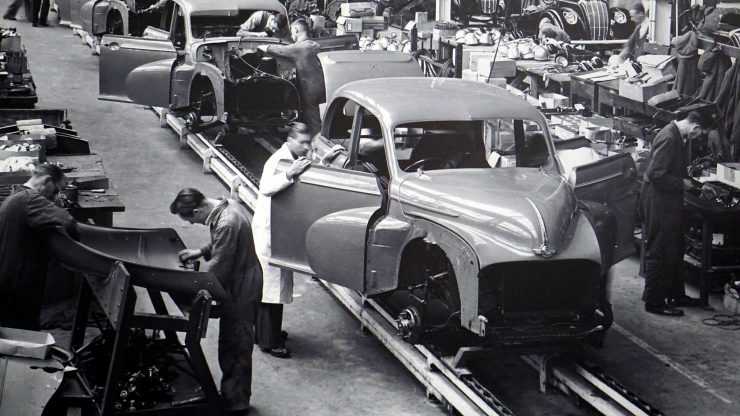The first step into a productive production line is understanding the definition of “waste”. In production, if something is a waste it does not mean it is trash or that it deserves to be thrown away. Anything that is not adding value to the customer is considered a waste. It is the company’s responsibility to minimize the amount of waste in their production line.
Generally if the specific action does not change the function of the product, if it is not done right the first time, or if the customer does not care about that process or is not willing to pay for that, it is considered waste. The Toyota Production System mentioned and focused on the seven mudras (T.I.M. W.O.O.D.), until Canon recognized that the misuse of workforce talent must also be considered a waste (T.I.M. W.O.O.D.S.).
1- Transformation
If the product cannot reach the customer the whole production process is wasteful. The transportation of information, materials and final products should be thoroughly optimized from end to end. Technology has helped modern businesses reduce transportation times and costs drastically, but out of the box thinking can still lead to better results. Typical transportation problems come from misaligned process flows, poorly designed systems and unnecessary steps in the production process. To improve transportation management inside your production line you can use methods like supply chain optimization, value stream mapping and linear programming.
2- Inventory management
Inventory management is the most problematic type of waste as when you have stored inventory, time is being lost while storing and fetching for the product. Extra inventory can also lead to defects from expiration and overproduction to lack of space for storage. Having too much inventory is usually misusing your working capital and space and can limit the company’s growth. It would be ideal to have 0 inventory and work in a just-in-time manner, but it is very hard to achieve as you need to be able to provide your product to your customers whenever they want it, they are usually not willing to wait. Inventory management problems usually come from overproduction caused by a misunderstanding on the customer needs, or from unreliable suppliers. You can reduce your inventory waste by optimizing your supply chain, having variation and capability studies and by modeling your inventory space.
3- Motion Control
Having an ergonomic workspace and reducing the travel space between tasks can reduce the time and energy required for a specific process. A worker should have access to all the tools he could need at arms length. Most motion control waste comes from poor workstation layout, workstation congestion or from shared tools and machines. To remove this waste, and optimize your production line, you can do a time and motion analysis in every process and adapt your plant space. All of the lost time when employees move to fetch a certain tool could be used in a more productive way.
4- Waiting Times
Every minute your product is sitting in line waiting to be worked on is considered a waste because there is no value being added by that time spent. Even if you are waiting for a previous step to finish, there is some space for improvement in your production line. Waiting times are very easy to identify and remove, you just have to find the way to produce as efficiently as possible. Typical waiting times include employee fatigue, machinery malfunction, resource scarcity or even waiting for approval from the manager. Pull production and using a workflow balancing method are both ways to remove your waiting time waste.
5- Over-Production
A long time ago, there was very little innovation in production, factories used to run at full capacity with a belief that having more was always better. In this decade, we are not able to sell at full production, and if we do, we would have to sell at a discount and that extra production turns into a problem. Task time analysis, pull production systems and demand leveling strategies are great tools to make sure you are producing the right amount.
6- Over-Processing / Non-Value Added Processing
With ever changing customer expectations, extra processes get added along the way to match what they are asking for. Many of these processes are taken for granted and are not really necessary to the functionality or overall appearance of the product. If you analyze your product´s production line carefully you could identify if there are any areas of opportunity. Most over processing problems come either from duplicated data or human error. In order to reduce over processing waste you can use a root cause analysis or a value stream mapping tool.
7- Defect Reduction
A defect would be considered anything that does not meet the customer’s requirements. If a defect is delivered to the client, it could affect your relationship with him/her and these mistakes require additional time, resources and money to fix. Some of the causes of defects include lack of standards, poor quality control, misunderstanding customer needs and having uncontrolled inventory levels. All of the six sigma tools can help reduce this kind of waste but good quality management skills are also needed.
8- Skill Management
Unused employees skills and creativity were not considered one of the major wastes that affect your production line under the Toyota Production system, but it was added in the late 90’s by Canon, and it is now regarded as important as the rest. Most companies realize that their most important asset is their employees as they have the power to drastically grow or derail a flourishing business. By listening to your employees ideas you are promoting self improvement that leads to a more successful company. Employees are able to see problems and processes from a different perspective and their ideas could make a difference in the production line. Typical misuse of talent comes from assigning staff to wrong tasks, lack of teamwork and insufficient training. You can take advantage of your employee’s full potential by having brainstorming sessions and other idea gathering techniques.
Every waste in the production line can be categorized into one of these waste groups. They should be removed to have a leaner and optimized production cycle. Even though these wastes are focused on a manufacturing business, they also apply to non-manufacturing industries from service providers to office management. By continually eliminating these wastes your business will have higher quality products, lower fixed costs, faster processes, and consequently happier workers and clients. So don’t forget TIM WOODS !
References:
- Liker, J. K. (2004). The Toyota way: 14 management principles from the world’s greatest manufacturer. New York: McGraw-Hill.
- I Six Sigma Group






